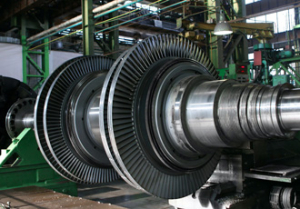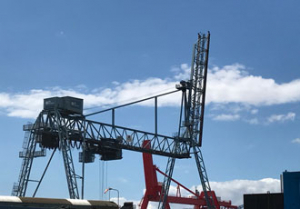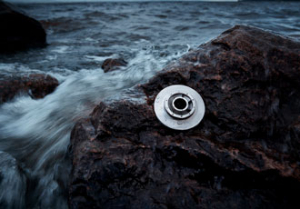High Productivity Gridning of Steel Mill Rolls
7th May 2013
Owners and operators of integrated steel production plants will be interested to hear that dramatic increases in the life of grinding wheels can be achieved when regenerating the steel or cast iron rolls in their rolling mills. Particularly impressive consumable savings result from using two recently introduced Norton brand products from Saint-Gobain Abrasives Ltd. One is QUANTUM, incorporating ceramic grain, while the other is VORTEX, which has fused alumina grain.
Both wheel types are engineered with a vitreous bond structure, resulting in free-cutting grinding. It maximises metal removal rate while drawing low power from the machine tool and producing minimal heat, consequently avoiding metallurgical damage.
Tests were carried out at Saint-Gobain Abrasives' research and development centre with a 915 mm diameter by 76 mm wide QUANTUM wheel on an 80 kW grinding machine. It processed a range of four different work roll and back-up roll materials – ICDP (indefinite chilled double poured) cast iron, high-chrome cast iron, CPC (continuous pouring process for cladding) high speed steel, and standard high speed steel – all for hot rolling mills. Surface finish achieved was between a half and one micron.
Results on ICDP were astonishing. Compared with the next best ceramic grinding wheel, QUANTUM had a 60 per cent higher grinding ratio, or G ratio, which is the amount in grams of metal removed per gram of wheel consumed. Compared with the worst wheel, QUANTUM performance was 140 per cent higher.
When processing a CPC HSS roll, the G ratio of the Saint-Gobain Abrasives product was around 60 per cent better than all the other ceramic grain wheels benchmarked. Chrome-iron and HSS roll grinding showed a smaller but still appreciable increase in wheel longevity. Across all the trials, the manufacturer claims an average increase in wheel life of 35 per cent.
Another test showed a rise in metal removal rate using QUANTUM of over 60 per cent, from a Q' of 2.3 up to 3.7 mm3/s/mm, while the power drawn from the grinder was 20 per cent less.
Part of the reason for the high performance of QUANTUM is that its newly developed ceramic grains have built-in fracture planes that enhance the wheel's capacity to self-sharpen. The sub-micron particles of ceramic break off at low mechanical pressure to expose new, sharp grain edges more readily.
VORTEX aluminium oxide grinding wheels have also proved effective at processing most rolls, but not work rolls used in hot rolling mills. The abrasive wheels cost less than QUANTUM and offer a proportionately lower G ratio. Nevertheless, VORTEX performance in roll grinding is still very high.
Reliability and accuracy are vital
Rolls for processing steel are made from various grades of iron or steel. They produce commercial products like sheets, strips, bars and plates of the required gauge and surface finish from thicker slabs and billets. These are formed in either a hot rolling mill if the steel is above its recrystallisation temperature or a cold rolling mill if the metal is below it. Steel is one of the most common materials in the world, with more than 1.4 billion metric tons produced annually.
Work rolls are exposed to high pressure and sometimes temperature, as these are the ones that contact the slabs. Back-up rolls, although they have to support the pressure exerted on the work rolls, are not in direct contact with the steel. Due to the extreme stresses on rolls in a steel mill, the demands on regrinding them are extraordinarily high with regard to accuracy and uptime.
The giant rolls, some of which can be 10 metres long and weigh 400 tonnes, need to be ground to an accuracy of under one micron. Rolls degrade during the rolling process and can become scratched or cracked, lose shape or even melt. At this point, the manufacturing process is stopped and the rolls need to be regenerated by way of specialised, high precision, cylindrical roll grinding.
The roll to be ground is clamped and driven in the spindle head of a manual or CNC grinder. The machine operator sets the parameters for cylindricity, final diameter, surface quality and structure or abrasion, depending on the required result. Laser read systems are often used to adjust grinding wheel rpm automatically relative to its diameter, thus maintaining optimum surface speed.
High precision, tactile measuring, or roll skating, of the rotating roll determines its size and shape as it is being machined, while eddy current testing non-destructively detects surface cracks and defects that must be ground out.
Steel mills are demanding longer service life from rolls between regrinds to minimise stoppages. So the materials used are constantly evolving to make the rolls harder, rendering them even more challenging to grind. There has been a progression from standard and highly alloyed ICDP cast iron through high-chrome and enhanced carbide cast irons to high-chrome stainless steels.
Many newer rolls are made from CPC HSS and spun-cast HSS, which have good compressive strength and red hardness retention. Chrome plating is another method for extending the life of the roll surface. These materials are very difficult to grind and require different specification wheels that are often highly engineered.
Many other factors come into play and must be accommodated when devising roll manufacturing and regrinding strategies. For example, cold rolling mills in particular require better finishes on rolls to meet ever higher demands from consumers with regard to the cosmetic appearance of end products.
Another issue is controlling the flatness and shape of a strip during rolling, which means that it often has a differential thickness between the edges and centre, a parameter known as crown. To achieve it, some rolls have to be ground with a continuously variable crown along their length.
Engineered solutions
Saint-Gobain Abrasives' grinding solutions ensure that customers achieve correct roll size, form and finish in optimal grinding cycle times. At the heart of its offering is a broad range of standard grinding wheels. Alternatively, the manufacturer can supply grinding wheels made-to-order at its new, world-class production plant in Eccleshall, near Stafford.
For the work roll in hot rolling mills, grinding requires fast metal removal but surface finish is not as critical as in cold rolling mills. The work roll is 600 mm to 800 mm in diameter in strip mills and up to 915 mm for plate. The length of the roll ranges from 1,600 mm to 3,400 mm. Saint-Gobain Abrasives has a number of grinding wheels for this application. Grit size usually ranges from 30 to 46 to achieve the required surface finish.
In cold rolling mills, less material is removed from the work roll but surface finish is critical, with a typical Ra of less than 0.4 μm. Diameter ranges from 300 mm to 760 mm and length is usually 2,500 mm. Grits 46 to 150 are found to achieve the surface finishes that are typically required.
At up to 1,600 mm diameter, back-up rolls in both types of rolling mill are larger than work rolls. They are either cast or forged and usually made from 2 to 5 per cent chromium steel. In some cases, ICDP cast iron and HSS are used. Back-up rolls are ground less frequently than work rolls, but significantly more material, as much as 2 mm on diameter, is generally removed. Grit size ranges from 24 to 36 to achieve target finish.
Rolls can be employed to flatten, size, shape or impart a finish to many materials, not only steel but also aluminium, brass and copper as well as paper and textiles. Saint-Gobain Abrasives offers a wide product portfolio to provide cost effective grinding of rolls to form all of these materials. Many other applications within the steel industry and elsewhere are catered for, from initial material conditioning through cutting slabs, billets and bars to grinding, finishing and polishing sheet, bar and tube.
Tests were carried out at Saint-Gobain Abrasives' research and development centre with a 915 mm diameter by 76 mm wide QUANTUM wheel on an 80 kW grinding machine. It processed a range of four different work roll and back-up roll materials – ICDP (indefinite chilled double poured) cast iron, high-chrome cast iron, CPC (continuous pouring process for cladding) high speed steel, and standard high speed steel – all for hot rolling mills. Surface finish achieved was between a half and one micron.
Results on ICDP were astonishing. Compared with the next best ceramic grinding wheel, QUANTUM had a 60 per cent higher grinding ratio, or G ratio, which is the amount in grams of metal removed per gram of wheel consumed. Compared with the worst wheel, QUANTUM performance was 140 per cent higher.
When processing a CPC HSS roll, the G ratio of the Saint-Gobain Abrasives product was around 60 per cent better than all the other ceramic grain wheels benchmarked. Chrome-iron and HSS roll grinding showed a smaller but still appreciable increase in wheel longevity. Across all the trials, the manufacturer claims an average increase in wheel life of 35 per cent.
Another test showed a rise in metal removal rate using QUANTUM of over 60 per cent, from a Q' of 2.3 up to 3.7 mm3/s/mm, while the power drawn from the grinder was 20 per cent less.
Part of the reason for the high performance of QUANTUM is that its newly developed ceramic grains have built-in fracture planes that enhance the wheel's capacity to self-sharpen. The sub-micron particles of ceramic break off at low mechanical pressure to expose new, sharp grain edges more readily.
VORTEX aluminium oxide grinding wheels have also proved effective at processing most rolls, but not work rolls used in hot rolling mills. The abrasive wheels cost less than QUANTUM and offer a proportionately lower G ratio. Nevertheless, VORTEX performance in roll grinding is still very high.
Reliability and accuracy are vital
Rolls for processing steel are made from various grades of iron or steel. They produce commercial products like sheets, strips, bars and plates of the required gauge and surface finish from thicker slabs and billets. These are formed in either a hot rolling mill if the steel is above its recrystallisation temperature or a cold rolling mill if the metal is below it. Steel is one of the most common materials in the world, with more than 1.4 billion metric tons produced annually.
Work rolls are exposed to high pressure and sometimes temperature, as these are the ones that contact the slabs. Back-up rolls, although they have to support the pressure exerted on the work rolls, are not in direct contact with the steel. Due to the extreme stresses on rolls in a steel mill, the demands on regrinding them are extraordinarily high with regard to accuracy and uptime.
The giant rolls, some of which can be 10 metres long and weigh 400 tonnes, need to be ground to an accuracy of under one micron. Rolls degrade during the rolling process and can become scratched or cracked, lose shape or even melt. At this point, the manufacturing process is stopped and the rolls need to be regenerated by way of specialised, high precision, cylindrical roll grinding.
The roll to be ground is clamped and driven in the spindle head of a manual or CNC grinder. The machine operator sets the parameters for cylindricity, final diameter, surface quality and structure or abrasion, depending on the required result. Laser read systems are often used to adjust grinding wheel rpm automatically relative to its diameter, thus maintaining optimum surface speed.
High precision, tactile measuring, or roll skating, of the rotating roll determines its size and shape as it is being machined, while eddy current testing non-destructively detects surface cracks and defects that must be ground out.
Steel mills are demanding longer service life from rolls between regrinds to minimise stoppages. So the materials used are constantly evolving to make the rolls harder, rendering them even more challenging to grind. There has been a progression from standard and highly alloyed ICDP cast iron through high-chrome and enhanced carbide cast irons to high-chrome stainless steels.
Many newer rolls are made from CPC HSS and spun-cast HSS, which have good compressive strength and red hardness retention. Chrome plating is another method for extending the life of the roll surface. These materials are very difficult to grind and require different specification wheels that are often highly engineered.
Many other factors come into play and must be accommodated when devising roll manufacturing and regrinding strategies. For example, cold rolling mills in particular require better finishes on rolls to meet ever higher demands from consumers with regard to the cosmetic appearance of end products.
Another issue is controlling the flatness and shape of a strip during rolling, which means that it often has a differential thickness between the edges and centre, a parameter known as crown. To achieve it, some rolls have to be ground with a continuously variable crown along their length.
Engineered solutions
Saint-Gobain Abrasives' grinding solutions ensure that customers achieve correct roll size, form and finish in optimal grinding cycle times. At the heart of its offering is a broad range of standard grinding wheels. Alternatively, the manufacturer can supply grinding wheels made-to-order at its new, world-class production plant in Eccleshall, near Stafford.
For the work roll in hot rolling mills, grinding requires fast metal removal but surface finish is not as critical as in cold rolling mills. The work roll is 600 mm to 800 mm in diameter in strip mills and up to 915 mm for plate. The length of the roll ranges from 1,600 mm to 3,400 mm. Saint-Gobain Abrasives has a number of grinding wheels for this application. Grit size usually ranges from 30 to 46 to achieve the required surface finish.
In cold rolling mills, less material is removed from the work roll but surface finish is critical, with a typical Ra of less than 0.4 μm. Diameter ranges from 300 mm to 760 mm and length is usually 2,500 mm. Grits 46 to 150 are found to achieve the surface finishes that are typically required.
At up to 1,600 mm diameter, back-up rolls in both types of rolling mill are larger than work rolls. They are either cast or forged and usually made from 2 to 5 per cent chromium steel. In some cases, ICDP cast iron and HSS are used. Back-up rolls are ground less frequently than work rolls, but significantly more material, as much as 2 mm on diameter, is generally removed. Grit size ranges from 24 to 36 to achieve target finish.
Rolls can be employed to flatten, size, shape or impart a finish to many materials, not only steel but also aluminium, brass and copper as well as paper and textiles. Saint-Gobain Abrasives offers a wide product portfolio to provide cost effective grinding of rolls to form all of these materials. Many other applications within the steel industry and elsewhere are catered for, from initial material conditioning through cutting slabs, billets and bars to grinding, finishing and polishing sheet, bar and tube.
Similar articles
More from Saint-Gobain Performance Plastics
- High Productivity Gridning of Steel Mill Rolls 7th May 2013
- Saint-Gobain Parts Transform Powertrain Components 4th November 2010
Product Centre Updates
2024 World Battery & Energy Storage Industry Expo (WBE)
8th August 2024
China 1st and 2nd Floor, Area A, China Import and Export Fair Complex

-(1)ed.jpg)










Write a comment
No comments